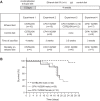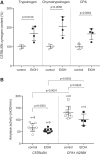Ethanol feeding accelerates pancreatitis progression in CPA1 N256K mutant mice
- PMID: 32116022
- PMCID: PMC7191466
- DOI: 10.1152/ajpgi.00007.2020
Ethanol feeding accelerates pancreatitis progression in CPA1 N256K mutant mice
Abstract
Alcoholic pancreatitis is a multifactorial, progressive, inflammatory disorder of the pancreas. Alcohol initiates pancreatitis and promotes its progression in the context of genetic susceptibility and/or other environmental risk factors such as smoking. Genetic mutations can cause digestive enzyme misfolding, which induces endoplasmic reticulum (ER) stress and elicits pancreatitis. Here, we tested the hypothesis that alcohol synergizes with misfolding in promoting ER stress and thereby accelerates chronic pancreatitis progression. To this end, we fed an ethanol-containing diet to CPA1 N256K mice, which carry the human p.N256K CPA1 mutation and develop spontaneous chronic pancreatitis. Inexplicably, CPA1 N256K mice suffered generalized seizures after 2-3 wk of ethanol feeding, which resulted in high mortality and the early termination of the study. Analysis of CPA1 N256K mice euthanized after 3-3.5 wk of ethanol feeding revealed more severe chronic pancreatitis associated with significantly increased Hspa5 [ER chaperone immunoglobulin heavy chain-binding protein (BiP)] mRNA levels when compared with CPA1 N256K mice on a control liquid diet. In contrast, ethanol feeding of C57BL/6N mice for 4 wk increased Hspa5 levels to a lesser degree and caused no pancreatitis. We conclude that ethanol feeding synergizes with the misfolding CPA1 mutant in promoting ER stress and thereby accelerates progression of chronic pancreatitis in CPA1 N256K mice.NEW & NOTEWORTHY Alcoholic pancreatitis is a multifactorial, progressive, inflammatory disorder of the pancreas. This study demonstrates that alcohol synergizes with digestive enzyme misfolding in promoting endoplasmic reticulum stress and thereby accelerates progression of chronic pancreatitis.
Keywords: chronic pancreatitis; endoplasmic reticulum stress; genetic mutation; mouse model.
Conflict of interest statement
No conflicts of interest, financial or otherwise, are declared by the authors.
Figures











References
-
- Coté GA, Yadav D, Slivka A, Hawes RH, Anderson MA, Burton FR, Brand RE, Banks PA, Lewis MD, Disario JA, Gardner TB, Gelrud A, Amann ST, Baillie J, Money ME, O’Connell M, Whitcomb DC, Sherman S; North American Pancreatitis Study Group . Alcohol and smoking as risk factors in an epidemiology study of patients with chronic pancreatitis. Clin Gastroenterol Hepatol 9: 266–273, 2011. doi:10.1016/j.cgh.2010.10.015. - DOI - PMC - PubMed
Publication types
MeSH terms
Substances
Grants and funding
LinkOut - more resources
Full Text Sources
Molecular Biology Databases
Miscellaneous

